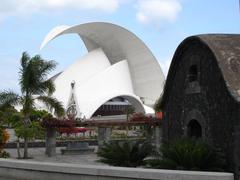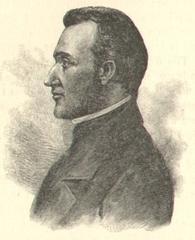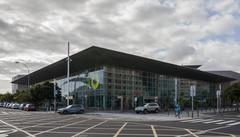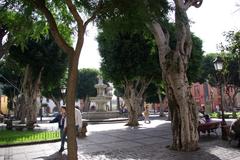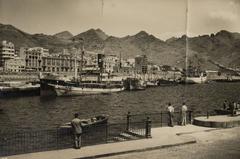Fort of Saint Peter: Visiting Hours, Tickets, and Travel Guide – Santa Cruz de Tenerife Historical Sites
Date: 14/06/2025
Introduction
The Fort of Saint Peter (Castillo de San Pedro), located along the vibrant waterfront of Santa Cruz de Tenerife, stands as a monument to the city’s maritime defense and cultural resilience. Built during a period when the Canary Islands were a keystone in Spain’s Atlantic ambitions, the fort has evolved from a military bulwark to a symbol of local pride and heritage. Today, it is a must-visit for history buffs, architecture enthusiasts, and travelers eager to uncover the stories behind Santa Cruz’s most iconic historical sites (Hello Canary Islands, Canarias Across).
This comprehensive guide details the fort’s history, cultural significance, practical visitor information—including current visiting hours and ticketing—accessibility tips, nearby attractions, and recommendations for making the most of your visit.
Historical Overview
Early Foundations and Strategic Importance
Santa Cruz de Tenerife was founded in 1494 and quickly became a strategic Atlantic port. The Fort of Saint Peter was constructed as part of a broader coastal defense network designed to protect the city’s harbor from pirates, privateers, and foreign navies from the 16th century onwards. Alongside Castillo de San Cristóbal and Castillo de San Juan Bautista, the fort played a key role in thwarting attacks, including the famous 1797 British assault led by Admiral Horatio Nelson (Canarias Across, World Guides).
Architectural Features and Evolution
Constructed with thick volcanic stone walls, angular bastions, and strategically placed artillery emplacements, the fort is a classic example of Renaissance and Baroque military architecture adapted to Atlantic conditions (GPSmyCity, Nomads Travel Guide). Over the centuries, as threats changed and the city expanded, the fort’s military importance waned, but its structure has been preserved as a testament to Santa Cruz’s historical legacy (Web Tenerife).
Cultural and Symbolic Significance
Beyond its military role, the Fort of Saint Peter is a symbol of the city’s resilience and identity. Annual commemorations, festivals, and reenactments—especially the July 25th celebration of the 1797 victory over Admiral Nelson—highlight the fort’s enduring presence in Santa Cruz’s collective memory (Out of Office Mindset, WelikeCanarias). The fort is also integrated into the city’s vibrant Old Town, surrounded by lively plazas, colonial architecture, and sites of cultural interest.
Visiting the Fort of Saint Peter: Essential Information
Location
The fort is situated adjacent to the harbor and within walking distance of Santa Cruz’s main attractions, including Plaza de España, the Church of the Immaculate Conception, and the TEA Tenerife Espacio de las Artes (Kekse und Koffer). It is easily accessible by public transport, with nearby bus and tram connections, and is convenient for those arriving by cruise ship.
Visiting Hours and Tickets
- Hours: The site is generally open daily from 9:00 AM to 6:00 PM. Some sources report 10:00 AM–6:00 PM. Hours may vary during holidays and special events—always check the official tourism website or information centers for current times.
- Admission: Free entry is standard, though guided tours or special exhibitions may require a ticket or donation.
- Guided Tours: Tours are available through local operators, especially during peak seasons or as part of the “Castle Route.” Advance booking is recommended for groups or during festivals (Guide to Canary Islands).
Accessibility
- The fort’s pathways are generally paved, but due to its historic nature, some areas may be difficult to access for those with mobility impairments.
- Ramps and accessible facilities are becoming more common in Santa Cruz, and staff or the local tourism office can provide assistance or information on accessible routes (Cruise Ports).
Facilities and Visitor Experience
- Restrooms, seating, and water fountains are available either on-site or nearby.
- Cafés and shops are close by, especially around Plaza de España.
- Informational panels in Spanish and English narrate the fort’s history.
- Excellent photography opportunities are available, especially at sunrise and sunset, thanks to panoramic views of the harbor and city skyline.
Special Events and Festivals
- Annual Reenactment: The fort is central to the July 25th reenactment of the 1797 Battle of Santa Cruz, with costumed performances and mock battles (The Nomadvisor).
- Cultural Events: Throughout the year, the fort hosts exhibitions, concerts, and forms part of city festivals like Fiestas de Mayo and Carnival.
Top Nearby Attractions
Combine your visit to the Fort of Saint Peter with these highlights:
- Plaza de España: The city’s main square, built over the remains of Castillo de San Cristóbal.
- Iglesia de la Concepción: The oldest church in Santa Cruz, exemplifying colonial architecture.
- TEA Tenerife Espacio de las Artes: A modern art and culture complex.
- Mercado Nuestra Señora de África: A bustling market with local produce and specialties.
- Parque Marítimo César Manrique and Palmetum Botanical Garden: For relaxation and further exploration (Guide to Canary Islands).
Visitor Tips
- Wear comfortable shoes for walking on stone surfaces.
- Bring sun protection (hat, sunscreen, water), especially in summer.
- Visit early or late in the day for the best light and fewer crowds.
- Photography is usually allowed—check for restrictions during events.
- Families and groups are welcome; supervise children near historic walls.
Frequently Asked Questions (FAQ)
Q: What are the Fort of Saint Peter visiting hours?
A: Typically 9:00 AM–6:00 PM daily, but check official sources for updates.
Q: Is there an entrance fee?
A: Entry is usually free; guided tours or special exhibitions may require a ticket or donation.
Q: Are guided tours available?
A: Yes, available through local operators and with digital audio guides.
Q: Is the fort accessible for disabled visitors?
A: Some areas are accessible, but there are steps and uneven surfaces. Contact the tourism office for details.
Q: Can I take photos?
A: Yes, except during some special exhibitions.
Q: What events are held at the fort?
A: The annual July 25th reenactment, cultural exhibitions, and concerts throughout the year.
Plan Your Visit
- How to Get There: Easily accessible by public transport (bus, tram) or on foot from the city center. Parking is available near the Auditorium and Palmetum.
- Food & Refreshments: Numerous cafés and restaurants are located nearby, offering local Canarian cuisine and international options.
- Language: Spanish is the official language, but English is widely spoken in tourist areas.
Enhance Your Experience
- Download the Audiala app for immersive audio tours and up-to-date information on Santa Cruz historical sites, including the Fort of Saint Peter.
- Check the official Santa Cruz tourism website for the latest opening hours, event calendars, and tour bookings.
- Follow local tourism and cultural channels on social media for event updates.
Conclusion
The Fort of Saint Peter is a cornerstone of Santa Cruz de Tenerife’s rich maritime past, offering visitors a compelling blend of history, architecture, and vibrant local culture. Its panoramic views, central location, integration with city festivals, and robust preservation efforts make it an essential stop for anyone exploring Santa Cruz historical sites. By planning ahead and utilizing available resources like guided tours and digital guides, visitors can fully appreciate the fort’s significance and enjoy a memorable experience at one of Tenerife’s most treasured landmarks.
References
- Hello Canary Islands
- Canarias Across
- Spain.info
- Out of Office Mindset
- The Nomadvisor
- WelikeCanarias
- Kekse und Koffer
- Guide to Canary Islands
- Cruise Ports
- Web Tenerife
- GPSmyCity
- Nomads Travel Guide
- World Guides
- Heather on her Travels
